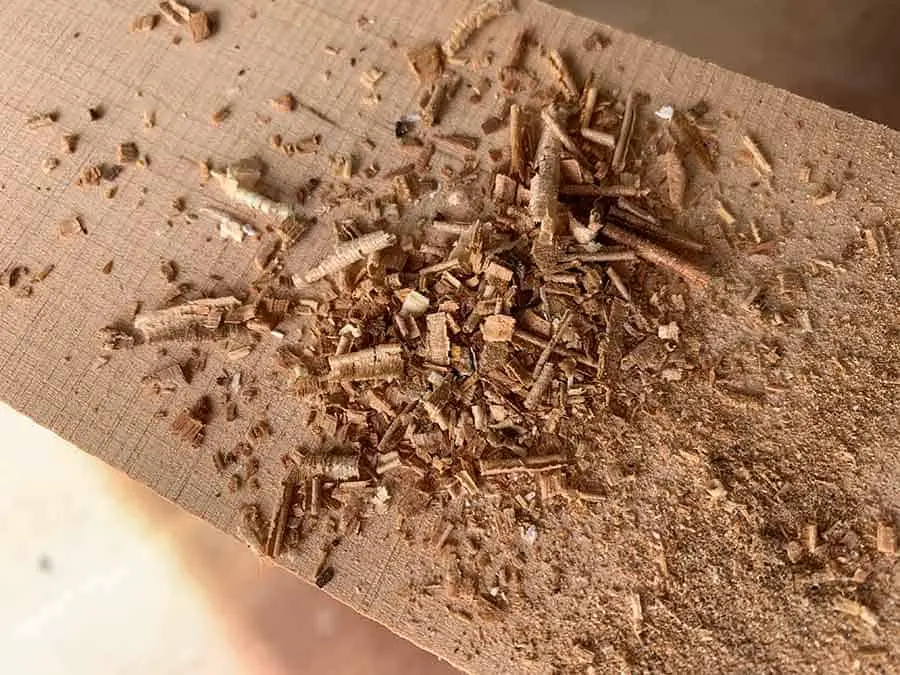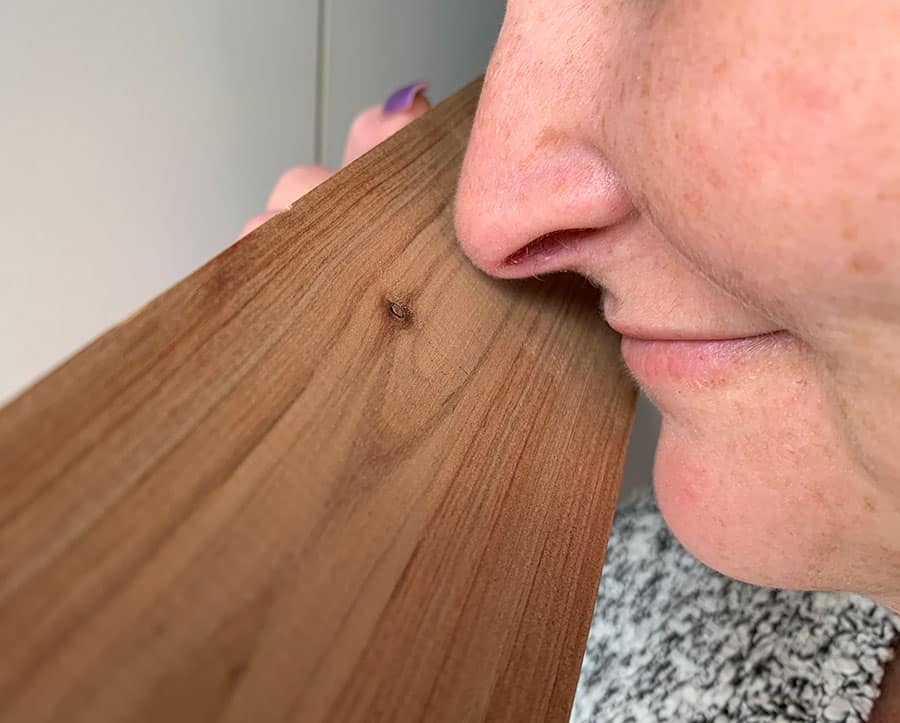While scent is a very subjective sense, a lot of people find the smell of sawdust appealing, even to the point of sawdust scented colognes being created. But what makes this unlikely substance so appealing? Why does sawdust smell so good?
It’s hard to say why we like the smell of sawdust since there hasn’t been much research into this topic. Most likely it is simply down to the fact that we like the smell of wood in general, and sawdust is just little pieces of wood. There are many reasons why we might like the smell of wood itself, so keep reading while we explore those reasons.
Wood You Like to Know More?
Terrible puns aside, it all comes down to the wood. Most people seem to like the smell of wood in all forms. Living wood, chemically treated wood, burning wood and, yes, wood that has been shaved into tiny pieces that we call sawdust.

We note how nice a room furnished with freshly made wood furniture smells, and take deep breaths and sigh contentedly when we are in a forest.
See my latest article does all cedar wood smell?
And it doesn’t seem to matter what kind of wood, either. While some woods are undoubtedly more popular than others (Pine, anybody?), there are very few woods that would be universally panned as smelling unpleasant. But what could the reasons for liking the smell of wood so much be?
We could dismiss it as merely “one of those things” if not for the fact that so many people feel this way. And when it comes to other things like sugar, we can point to evolutionary reasons why it is generally desirable to everybody.
But, while we can’t do the same for the smell of wood, we can hypothesize along the same lines. For example, we evolved from tree-dwelling monkeys.
While we would eventually head out into the open expanses of the plains, there was a time in our evolutionary history when forests and jungles were our home.
It is entirely possibly-and entirely guesswork that our positive response to the smell of wood is an evolutionary byproduct. After all, for those tree-dwelling ancestors, trees meant safety. You could climb trees to escape predators.
So perhaps that is where is our love of the smell of wood comes from. Then again, it could also be a purely biological quirk that wood happens to be a smell that we like, and there is no deeper meaning beyond that.

What is Sawdust?
Could there be anything special about sawdust specifically? Absolutely. The theory that wood is the root cause stems from the observation that we like the smell of wood in a variety of forms, and sawdust is just another form of wood.
However, it could be a coincidence, and sawdust may indeed have some special attribute that attracts us to its scent. So let’s take a look at what sawdust is.
When wood is worked, whether it is a large-scale industrial process like a lumbermill, or something a little more intricate, like building furniture, there will inevitably be excess wood that is cut, trimmed, and shaved away from the piece that is being worked on.
The process of doing this creates small pieces of wood that vary in size from shavings to tiny particles. Sawdust is the name for the smaller, particle-sized pieces of wood.
When enough sawdust collects in one place, it looks like a pile of dust, albeit a lighter, nicer smelling pile of dust.
Wood has a tendency to seal itself when exposed to the environment so that the fresh wood smell you are familiar with will eventually fade, however cutting wood up exposes fresh parts of the wood, which releases a renewed scent.
Bringing the Heat
There is another significant component to sawdust that is not part of the standard wood smell, that is heat-specifically the smell of burning wood. Cutting wood, even with the sharpest possible blade, involves friction.
The process of cutting is still just dragging a harder material across the wood and essentially rubbing part of the wood away. Granted, in the case of a saw blade, the harder material is sharp, serrated, and very thin, but the premise remains the same.
Any time you rub two materials together, you generate heat, and cutting wood is no exception to that rule. And, of course, wood burns. Famously so. Cutting wood ever so slightly burns it, perhaps less slightly if cut with a blunt blade, or too quickly.
We mentioned at the top that burning wood-particularly things like campfires-are another form of wood smell that is popular, and this may also be part of why the smell of sawdust is popular.
Is Sawdust Dangerous?
We’ve talked about some potential reasons why sawdust might appeal to your sense of smell, but should you be smelling it at all? As stated above, sawdust is essentially small pieces of wood, some of them too small to be seen.
If they are too small to be seen, they can be inhaled, and inhaling pieces of wood-no matter how small-is bad news for your respiratory system. In fact, it is a known carcinogen, and exposure to wood dust has been linked to increases in cancer of the nose.
Of course, this doesn’t mean smelling the smell of sawdust will give you cancer; however, you should definitely avoid taking any deep breaths in close proximity to freshly cut wood.
It is for this reason that people who work with wood for a living wear masks to protect themselves from inhaling fine sawdust particles, and why many countries and regions have regulations that require a certain level of safety equipment required in order to work with wood.
Uses for Sawdust
As it turns out, sawdust has a lot of useful properties that make it ideal for certain situations around the home or workplace. If you work with wood regularly, or you happen to be working on a job that involves a lot of woodwork, it might be worth keeping all that sawdust you create. You never know when it might come in handy…
Scent Masking
One such use is masking unpleasant scents, such as you might get from a compost heap or a composting toilet. Liberally sprinkling sawdust over the source of the offending odor can do wonders for cutting down the potency of that odor and even nullifying it entirely.
Spillage Cleanup
Another widespread use is for soaking up spillages, particularly those harder to clean spillages, like motor oil. Sawdust is very absorbent, and can typically soak up the spilt liquid and then simply be shoveled or swept up afterwards.
It is not uncommon to find a barrel full of sawdust in the corner at an auto shop for this very reason. If you work with tricky liquids, it can’t hurt to have a tub of sawdust lying around in case you ever find yourself having to clean some of that liquid up!
Making Wood Filler
If you are working with wood, you may, on occasion, find yourself in need of a little patch up. It’s nothing to be ashamed of; we all make mistakes. Of course, wood isn’t the easiest thing to repair when you’ve accidentally taken a little too much out.
Fear not, however, for you can put all that sawdust to good use.
By mixing wood glue and sawdust, you can make a very effective wood patching paste. Granted, it won’t look indistinguishable from the original surface, but it will look a whole lot better than a gouge or hole.
Things to Avoid Using Sawdust For
Sawdust is not suitable for everything, of course, and there are many things that might seem like a good idea at first that are actually really bad ideas. For example, it used to be common to put sawdust in fish tanks as a kind of homemade alternative to activated charcoal.
This should be avoided as the sawdust can actually end up starving the water of oxygen, which is clearly bad news for the fish.
Sticking with the theme of pets, it’s not always a good idea to use sawdust as bedding for your little furry ones-regardless of what type of little furry one it is. Admittedly, this one depends on the type of wood your sawdust comes from.
If you are using sawdust from a freshly cut tree, it’s probably fine. If you have been cutting up chemically treated wood from the lumberyard, keep it away from your rabbits and gerbils!
It’s also worth noting that small pets don’t like nose cancer any more than we humans do. If you are going to use sawdust in your pet cage, stick to the larger variant, such as shavings from planed wood. You can filter out the smaller harmful dust with a regular household sieve.
Conclusions: Why Does Sawdust Smell So Good?
Unfortunately, we just don’t know. All we can say for sure is that it is a very popular smell. And that you should absolutely not go burying your head in a pile of fine, powdery sawdust to get a fix of that popular smell!



